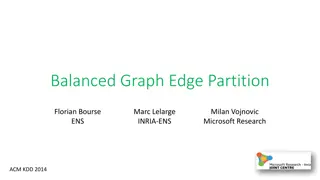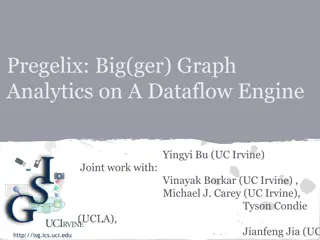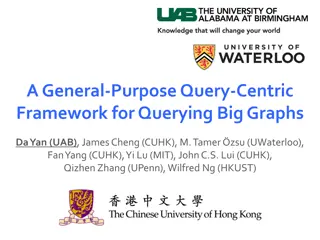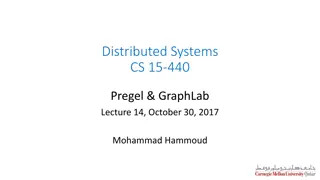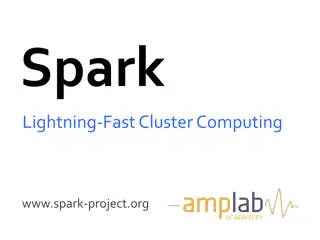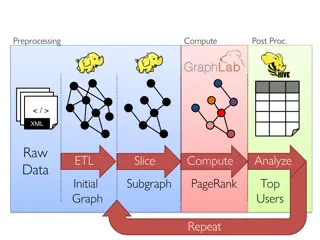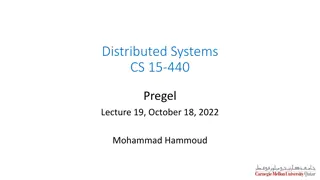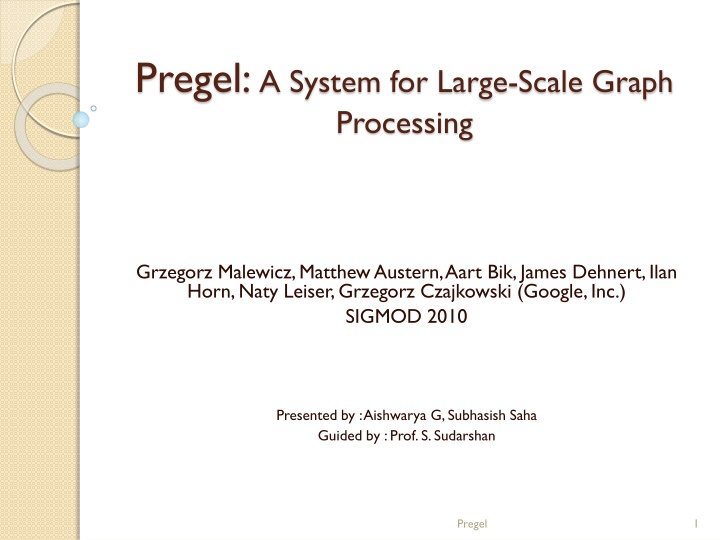
Large-Scale Graph Processing with Pregel System
Explore how Pregel, a scalable and fault-tolerant platform, revolutionizes large-scale graph processing by offering a flexible API for expressing complex algorithms and implementing a vertex-centric computation model. Overcoming challenges in graph algorithms, Pregel addresses the need for a distributed, fault-tolerant solution in handling practical computing problems related to web graphs, social networks, and more. Discover the motivation, computation model, and alternatives in graph processing presented in this insightful study.
Download Presentation

Please find below an Image/Link to download the presentation.
The content on the website is provided AS IS for your information and personal use only. It may not be sold, licensed, or shared on other websites without obtaining consent from the author. If you encounter any issues during the download, it is possible that the publisher has removed the file from their server.
You are allowed to download the files provided on this website for personal or commercial use, subject to the condition that they are used lawfully. All files are the property of their respective owners.
The content on the website is provided AS IS for your information and personal use only. It may not be sold, licensed, or shared on other websites without obtaining consent from the author.
E N D
Presentation Transcript
Pregel: A System for Large-Scale Graph Processing Grzegorz Malewicz, Matthew Austern,Aart Bik, James Dehnert, Ilan Horn, Naty Leiser, Grzegorz Czajkowski (Google, Inc.) SIGMOD 2010 Presented by : Aishwarya G, Subhasish Saha Guided by : Prof. S. Sudarshan Pregel 1
MOTIVATION Pregel 2
Motivation Many practical computing problems concern large graphs (web graph, social networks, transportation network). Example : Shortest Path Clustering Page Rank Minimum Cut Connected Components Pregel 3
Graph algorithms: Challenges [1] Very little computation work required per vertex. Changing degree of parallelism over the course of execution. Munagala and Ranade [2] showed the lower bounds I/O Complexity for Graph algorithms Pregel 4
Motivation Alternatives : Create distributed infrastructure for every new algorithm Map Reduce Inter-stage communication overhead Single computer graph library does not scale Other parallel graph systems no fault-tolerance Need for a scalable distributed solution Pregel 5
Pregel Scalable and Fault-tolerant platform API with flexibility to express arbitrary algorithm Inspired by Valiant s Bulk Synchronous Parallel model[4] Vertex centric computation (Think like a vertex) Pregel 6
COMPUTATION MODEL Pregel 7
Computation Model (1/4) Input Supersteps (a sequence of iterations) Output Source: http://en.wikipedia.org/wiki/Bulk_synchronous_parallel Pregel 8
Computation Model (2/4) Source: http://en.wikipedia.org/wiki/Bulk_synchronous_parallel Pregel 9
Computation Model (3/4) Concurrent computation and Communication need not be ordered in time Communication through message passing Each vertex Receives messages sent in the previous superstep Executes the same user-defined function Modifies its value or that of its outgoing edges Sends messages to other vertices (to be received in the next superstep) Mutates the topology of the graph Votes to halt if it has no further work to do Pregel 10
Computation Model (4/4) State machine for a vertex Termination condition All vertices are simultaneously inactive There are no messages in transit Pregel 11
Example Single Source Shortest Path Find shortest path from a source node to all target nodes Example taken from talk by Taewhi Lee ,2010 http://zhenxiao.com/read/Pregel.ppt Pregel 12
Example: SSSP Parallel BFS in Pregel 1 10 9 2 3 4 6 0 Inactive Vertex Active Vertex x Edge weight 5 7 Message x 2 Pregel 13
Example: SSSP Parallel BFS in Pregel 1 10 10 Inactive Vertex 9 2 3 4 6 0 Active Vertex x Edge weight 5 Message 7 x 5 2 Pregel 14
Example: SSSP Parallel BFS in Pregel 1 10 10 Inactive Vertex 9 2 3 4 6 0 Active Vertex x Edge weight 5 Message 7 x 5 2 Pregel 15
Example: SSSP Parallel BFS in Pregel 11 1 10 14 8 10 Inactive Vertex 9 2 3 4 6 0 Active Vertex x Edge weight 5 Message 12 7 x 5 7 2 Pregel 16
Example: SSSP Parallel BFS in Pregel 1 8 11 10 Inactive Vertex 9 2 3 4 6 0 Active Vertex x Edge weight 5 Message 7 x 5 7 2 Pregel 17
Example: SSSP Parallel BFS in Pregel 9 1 8 11 10 13 Inactive Vertex 9 14 2 3 4 6 0 Active Vertex x Edge weight 5 Message 7 15 x 5 7 2 Pregel 18
Example: SSSP Parallel BFS in Pregel 1 8 9 10 Inactive Vertex 9 2 3 4 6 0 Active Vertex x Edge weight 5 Message 7 x 5 7 2 Pregel 19
Example: SSSP Parallel BFS in Pregel 1 8 9 10 Inactive Vertex 9 2 3 4 6 0 Active Vertex x Edge weight 5 Message 13 7 x 5 7 2 Pregel 20
Example: SSSP Parallel BFS in Pregel 1 8 9 10 Inactive Vertex 9 2 3 4 6 0 Active Vertex x Edge weight 5 Message 7 x 5 7 2 Pregel 21
Differences from MapReduce Graph algorithms can be written as a series of chained MapReduce invocation Pregel Keeps vertices & edges on the machine that performs computation Uses network transfers only for messages MapReduce Passes the entire state of the graph from one stage to the next Needs to coordinate the steps of a chained MapReduce Pregel 22
THE API Pregel 23
Writing a Pregel program Subclassing the predefined Vertex class Override this! in msgs Modify vertex value out msg Pregel 24
Example: Vertex Class for SSSP Pregel 25
SYSTEM ARCHITECTURE Pregel 26
System Architecture Pregel system also uses the master/worker model Master Coordinates worker Recovers faults of workers Worker Processes its task Communicates with the other workers Persistent data is in distributed storage system (such as GFS or BigTable) Temporary data is stored on local disk Pregel 27
Pregel Execution (1/4) Many copies of the program begin executing on a cluster of machines 1. Master partitions the graph and assigns one or more partitions to each worker 2. Master also assigns a partition of the input to each worker 3. Each worker loads the vertices and marks them as active Pregel 28
Pregel Execution (2/4) The master instructs each worker to perform a superstep 4. Each worker loops through its active vertices & computes for each vertex Messages are sent asynchronously, but are delivered before the end of the superstep This step is repeated as long as any vertices are active, or any messages are in transit After the computation halts, the master may instruct each worker to save its portion of the graph 5. Pregel 29
Pregel Execution (3/4) http://java.dzone.com/news/google-pregel-graph-processing Pregel 30
Pregel Execution (4/4) http://java.dzone.com/news/google-pregel-graph-processing Pregel 31
Combiner Worker can combine messages reported by its vertices and send out one single message Reduce message traffic and disk space http://web.engr.illinois.edu/~pzhao4/ Pregel 32
Combiner in SSSP Min Combiner class MinIntCombiner : public Combiner<int> { virtual void Combine(MessageIterator* msgs) { int mindist = INF; for (; !msgs->Done(); msgs->Next()) mindist = min(mindist, msgs->Value()); Output("combined_source", mindist); } }; Pregel 33
Aggregator Used for global communication, global data and monitoring Compute aggregate statistics from vertex-reported values During a superstep, each worker aggregates values from its vertices to form a partially aggregated value At the end of a superstep, partially aggregated values from each worker are aggregated in a tree structure Tree structure allows parallelization Global aggregate is sent to the master Pregel 34
Aggregator http://web.engr.illinois.edu/~pzhao4/ Pregel 35
Topology Mutations Needed for clustering applications Ordering of mutations: deletions taking place before additions, deletion of edges before vertices and addition of vertices before edges Resolves rest of the conflicts by user-defined handlers. Pregel 36
Fault Tolerance (1/2) Checkpointing The master periodically instructs the workers to save the state of their partitions to persistent storage e.g., Vertex values, edge values, incoming messages Failure detection Using regular ping messages Pregel 37
Fault Tolerance (2/2) Recovery The master reassigns graph partitions to the currently available workers All workers reload their partition state from most recent available checkpoint Confined Recovery Log outgoing messages Involves only the recovering partition Pregel 38
APPLICATIONS PageRank Pregel 39
PageRank Used to determine the importance of a document based on the number of references to it and the importance of the source documents themselves A = A given page T1 . Tn = Pages that point to page A (citations) d = Damping factor between 0 and 1 (usually kept as 0.85) C(T) = number of links going out of T PR(A) = the PageRank of page A ( T ) ( T ) ( T ) PR T PR T PR T = + + + + ( ) 1 ( ) ( ........ ) 1 2 n PR A d d ( ) ( ) ( ) C C C 1 2 n Pregel 40
PageRank Courtesy: Wikipedia Pregel 41
PageRank Iterative loop till convergence Initial value of PageRank of all pages = 1.0; While ( sum of PageRank of all pages numPages > epsilon) { for each Page Pi in list { PageRank(Pi) = (1-d); for each page Pj linking to page Pi { PageRank(Pi) += d (PageRank(Pj)/numOutLinks(Pj)); } } } Pregel 42
PageRank in Pregel Superstep 0: Value of each vertex is 1/NumVertices() virtual void Compute(MessageIterator* msgs) { if (superstep() >= 1) { double sum = 0; for (; !msgs->done(); msgs->Next()) sum += msgs->Value(); *MutableValue() = 0.15 + 0.85 * sum; } if (supersteps() < 30) { const int64 n = GetOutEdgeIterator().size(); } else { SendMessageToAllNeighbors(GetValue() / n); VoteToHalt(); } Pregel 43 }
APPLICATIONS Bipartite Matching Pregel 44
Bipartite Matching Input : 2 distinct sets of vertices with edges only between the sets Output : subset of edges with no common endpoints Pregel implementation : randomized maximal matching algorithm The vertex value is a tuple of 2 values: a flag indicating which set the vertex is in (L or R) name of its matched vertex once it is known. Pregel 45
Bipartite Matching Cycles of 4 phases Phase 1: Each left vertex not yet matched sends a message to each of its neighbors to request a match, and then unconditionally votes to halt. Phase 2: Each right vertex not yet matched randomly chooses one of the messages it receives, sends a message granting that request and sends messages to other requestors denying it. Then it unconditionally votes to halt. Phase 3: Each left vertex not yet matched chooses one of the grants it receives and sends an acceptance message. Phase 4: Unmatched right vertex receives at most one acceptance message. It notes the matched node and unconditionally votes to halt. Pregel 46
Bipartite Matching in Pregel (1/2) Class BipartiteMatchingVertex : public Vertex<tuple<position, int>, void, boolean> { public: virtual void Compute(MessageIterator* msgs) { switch (superstep() % 4) { case 0: if (GetValue().first == L ) { SendMessageToAllNeighbors(1); VoteToHalt(); } case 1: if (GetValue().first == R ) { Rand myRand = new Rand(Time()); for ( ; !msgs->Done(); msgs->Next()) { if (myRand.nextBoolean()) { SendMessageTo(msgs->Source, 1); break; } Pregel 47 }
Bipartite Matching in Pregel (2/2) case 2: if (GetValue().first == L ) { Rand myRand = new Rand(Time()); for ( ; !msgs->Done(); msgs->Next) { if (myRand.nextBoolean()) { *MutableValue().second = msgs->Source()); SendMessageTo(msgs->Source(), 1); break; } } VoteToHalt(); } case 3: if (GetValue().first == R ) { msgs->Next(); *MutableValue().second = msgs->Source(); } VoteToHalt(); Pregel 48 }}};
Bipartite Matching : Cycle 1 Execution of a cycle (A cycle consists of 4 supersteps) Pregel 49
EXPERIMENTS Pregel 50

